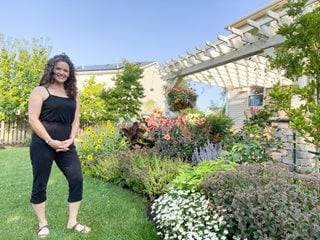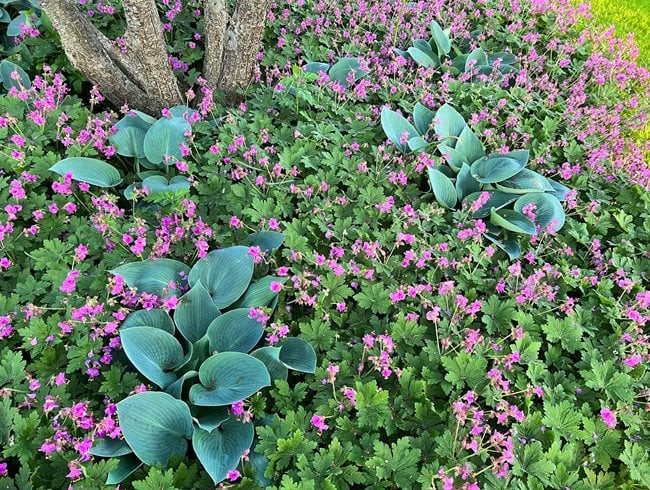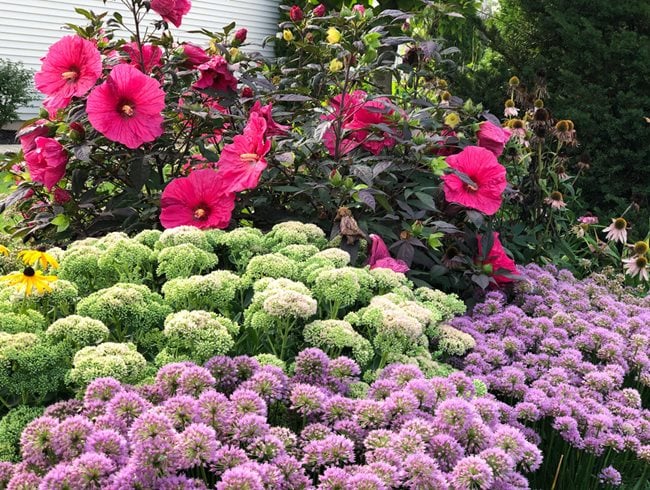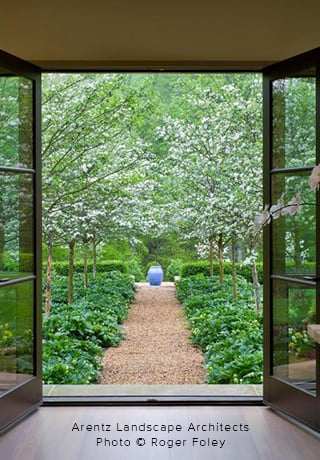Suburban Garden Magic
How Heather Blackmore created a space that encourages wonder and an appreciation for nature in her own compact backyard garden.
Heather stands next to a bed in her sunny patio garden in suburban Chicago. Photo courtesy Heather Blackmore.
It wasn’t one defining experience that compelled Heather Blackmore of Here She Grows to become the gardener she is today. Rather, it was the convergence of many influences and moments that led to her full-fledged love for gardening—and her desire to share that love with others. Growing up, Heather’s parents had a modest vegetable garden and a few rose plants. And she was no stranger to the natural world. “My family didn’t have a lot of money, so my entertainment was long walks in the woods, which I loved,” she shares. “I was always kind of immersed in nature.”
It was in high school when her interest in plants really started to grow. “I had moved into a new town and didn’t have a lot of friends,” Heather says. “A lady who lived on the street next to us was giving away houseplants, and she gifted me a philodendron.” Heather kept that philodendron in her room for years. “Caring for that plant really touched me,” she says. While still in high school, Heather began working at a local greenhouse where she learned more about tending to and propagating plants—an activity she became fascinated with.
During college, Heather immersed herself in studying to become a journalist. Though her love for gardening never faded, getting her hands in the dirt was placed on hold for a while. It wasn’t until she was married and started staying home with her kids that she jumped back into the world she’d loved so much. “There were weeds everywhere at our first house,” she recalls. “I didn’t know what I was doing, but I went for it.”
Heather checked out dozens of gardening books at her local library, soaking up as much information as possible. “I killed a lot of plants,” Heather shares. “But that’s how you learn. I didn’t give up.” Soon, she became a Master Gardener. Eventually, Heather’s experience as a journalist and love of gardening collided beautifully: She began writing content for Better Homes & Gardens, started her blog Here She Grows, and now she creates gardening content for her followers on Instagram and YouTube.

On the west side of Heather’s backyard, a stone path set in Elfin creeping thyme leads to a gate that takes you to the front yard garden. Sedum, vibrant purplish-pink petunias, catmint, and Pink Chiffon® rose of Sharon with its ballet slipper pink blooms line the pathway, brightening the space. Photo courtesy Heather Blackmore.
Today, Heather gardens on a suburban Chicago lot that lives larger because of the garden. She loves sharing about her experiences on her blog and social media, but after talking with her for a bit, it becomes clear that it’s the in-person interactions that mean the most to her. When her two daughters were little, Heather made it a point to involve them and encourage their sense of curiosity for plants and the natural world. “Even as adults, they have a sense of wonder,” says Heather. “They like to observe. It’s deeply rooted in them because they’ve been doing it since they were babies.”
Though her daughters are grown, Heather’s passion for encouraging wonder in the next generation continues. As families in the neighborhood walk by, kids are often drawn to the bright plants in her front yard. If she’s outside, Heather doesn’t hesitate to tell parents to go ahead and get a closer look, urging them to let their kids touch the plants. “I especially love showing them monarch eggs on my milkweed plants,” says Heather. “Witnessing that lifecycle up-close is an amazing thing for them to witness.” These moments might seem simple while they’re happening–but, similar to the day teenage Heather’s neighbor gifted her a philodendron, their impact is lasting. “I think of it as my legacy.”
5 Tips for Small Suburban Spaces
Heather has made the most of her small-space garden in the southwest suburbs of Chicago, Zone 5b. Here, she offers tips so you can maximize your own space and create your own haven for wonder and enjoyment.
Take Your Time

Noting that this area of her front yard sees a significant amount of shade throughout the day, Heather chose plants that would thrive in the space such as silvery-green hostas, hydrangeas (in foreground at right and in front of the Katsura lantern). Burgundy heuchera adds complementary contrast to the color scheme while Mount Everest alliums rise above it all. Photo courtesy Heather Blackmore.
Before making big decisions or changes to your outdoor space, sit with it and get to know it, recommends Heather. And not only from the outside. “Look at it from the inside, too,” she says. “That will help inform what views you want to block or enhance.” Here are some elements to pay close attention to:
- Views. What do you want to see when you look out the windows of your home?
- Privacy. Do you need to obscure any views of neighboring homes?
- Lighting. Which areas have the best lighting? Do you have any shady spots?
Heather emphasizes the importance of slowing down and really understanding your space. “Gardening is about the experience,” she says. “The garden evolves as the gardener evolves.
Use Fewer Plants, But Plant Them en Masse

A grouping of blue hostas, which were a gift from a neighbor (variety unknown), interspersed throughout a sea of bigroot geranium makes an impression. Photo courtesy Heather Blackmore.
It’s hard to resist the urge to get one of everything, but Heather strongly suggests planting multiples of the same plant together. “It has a much better impact,” she says. “Instead of ten types, maybe do five types, but plant them in a group of five or seven.” One of this and one of that in a space can tend to look messy. In addition to creating a more cohesive design, planting in groups helps with success. “You’re more likely to get to know those plants better,” says Heather.
Balance Plant Sizes

Large, impactful plants can make a small garden feel bigger. Here, Heather stands next to a Musa basjoo (hardy banana) next to her home. Photo courtesy Heather Blackmore.
Choosing the right-sized plants for small outdoor spaces is a balancing act. On one hand, you need to make sure your plants won’t outgrow your garden. On the other hand, adding big, dramatic plants can make a space feel larger. Heather elaborates on finding the sweet spot:
- Avoid plants that are too big for your space…It’s crucial to pay attention to a plant’s mature size to make sure it’s right for your space. Is there a plant you’re set on that will eventually grow way too big? Heather encourages gardeners to look around for a variety that will work. For example, “You can’t include a full-sized elderberry in a postage-stamp sized space,” she says. “Instead you could use Laced Up® Elderberry in its place.” Unsure about the right replacement? Heather recommends going to a reputable garden center and showing them what you like. They’ll help you find a variety that will work, or at least a plant with similar qualities.
- …but include some large plants for impact! Yes, you need to make sure your plants won’t outgrow your space, but there’s always room for large, impactful plants that won’t overtake your garden. “Too small is boring,” says Heather, “and big leaves create the illusion of more space.” Heather suggests dramatic plants such as cannas, elephant ears, and Musa basjoo (hardy banana) that bring drama and help create the illusion of a larger space.
Consult a Color Wheel

Pleasing to the eye, this grouping of plants features purplish-pink Millenium allium, hot pink ‘Evening Rose’ hibiscus pale pink ‘Magnus’ coneflower and Goldsturm rudbeckia. A lime green ‘Autumn Joy’ sedum, which will soon turn pink, sits at the opposite end of the color wheel as its neighbors, providing a contrasting color that complements the others. Photo courtesy Heather Blackmore.
Often underestimated, a color wheel is invaluable when coming up with stunning plant combinations—especially if you have limited space to work with. Like every gardener, Heather admits to doing her fair share of impulse buying but tries sticking to plants in colors that complement each other or accentuate each other. “Figure out what color combinations you want, then pick plants with flowers and foliage based on those combinations for a cohesive look.”
If a set color palette makes you feel too constrained, you don’t have to limit yourself to the same palette throughout your entire garden. Instead, you can opt to choose different palettes for different areas which will help you define each space.

Sharing a bed with a group of Millenium allium, a ‘Blue Cloak’ fir tree provides silvery blue-green foliage all year long. Photo courtesy Heather Blackmore.
Including plants with foliage that put on a show at different times of the year is key in a small space. “We all want flowers, of course, but I think foliage is the unsung hero of the garden,” notes Heather, suggesting plants that “go beyond ‘one-and-done’ foliage.” Heather recommends incorporating evergreens, trees, and other plants with eye-catching qualities such as Black Lace® elderberry, Amber Jubilee™ ninebark, and red twig dogwood to name a few.
Heather’s Top Plants for Small Suburban Spaces
If you have a limited amount of space to work with, it helps to be discerning when choosing what to include. “I try to focus on plants that can do more than just one thing,” shares Heather. Along with choosing plants that are water-wise (Heather doesn’t use drip irrigation), she also opts for low-maintenance plants, noting “I don’t want plants I have to babysit!” Here are ten of her favorites.








